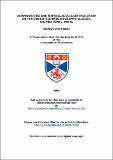Files in this item
Downwasting and supraglacial lake evolution on the debris-covered Ngozumpa Glacier, Khumbu Himal, Nepal
Item metadata
| dc.contributor.advisor | Benn, Douglas I. | |
| dc.contributor.author | Hands, Kathryn Ann | |
| dc.coverage.spatial | xviii, 274 p. | en_US |
| dc.date.accessioned | 2015-08-05T09:21:46Z | |
| dc.date.available | 2015-08-05T09:21:46Z | |
| dc.date.issued | 2004 | |
| dc.identifier | uk.bl.ethos.635896 | |
| dc.identifier.uri | https://hdl.handle.net/10023/7128 | |
| dc.description.abstract | In recent decades, the downwasting of several debris-covered glaciers in the Himalaya has led to the formation of large and potentially hazardous moraine- dammed lakes. The frequency of Glacial Lake Outburst Flood (GLOF) events in the Himalaya has steadily increased since the 1970s and as global temperatures continue to rise this trend is set to continue in the future. Downwasting of the debris-covered Ngozumpa Glacier in the Khumbu Himal, Nepal, has resulted in the abandonment of the lateral and terminal moraine crests, leaving them standing several tens of metres above the glacier surface. The moraines have exerted a control on the drainage of meltwater from the glacier surface and have encouraged ponding of meltwater on the glacier surface. The present study examines the evolution of perched supraglacial ponds on the Ngozumpa Glacier and assesses how the growth of these ponds affects the rate of downwasting of the glacier surface. The expansion rates of perched ponds can be rapid, up to 21,609 m ² a⁻¹, but the growth of these ponds tends to be terminated when contact is made with the englacial drainage network. The thesis documents for the first time a complete cycle of perched supra glacial pond growth and drainage and also provides direct evidence for internal ablation during pond drainage, a process that has only been inferred in previous research. The western lateral moraine has dammed back drainage from the western tributary valleys, resulting in the formation of laterally-dammed lakes. The research presented here examines the processes and rates of paraglacial reworking of the Ngozumpa moraines in order to assess the stability and longevity of the moraine dam. Approximately 1 km from the Ngozumpa terminus a large Spillway Lake has formed. Meltwater from upglacier is channelled into the lake and exits the glacier surface through an over-spill channel cut down through the western lateral moraine. The level of the Spillway Lake is thereby controlled by the height of the spillway channel through the western lateral moraine. The rate of expansion of the Spillway Lake is lower than that of the perched ponds upglacier, but as the Spillway Lake continues to enlarge and surface downwasting of the glacier surface proceeds, the lake could enter a period of rapid and unstable growth. By analogy with other glaciers in the Khumbu Rimal, it is possible that a large and potentially hazardous lake will form on the Ngozumpa within the next two decades. | en_US |
| dc.language.iso | en | en_US |
| dc.publisher | University of St Andrews | |
| dc.subject.lcc | GB2559.N4H2 | |
| dc.subject.lcsh | Glaciers -- Nepal -- Khumbu Himal | en_US |
| dc.subject.lcsh | Limnology -- Nepal -- Khumbu Himal | en_US |
| dc.title | Downwasting and supraglacial lake evolution on the debris-covered Ngozumpa Glacier, Khumbu Himal, Nepal | en_US |
| dc.type | Thesis | en_US |
| dc.type.qualificationlevel | Doctoral | en_US |
| dc.type.qualificationname | PhD Doctor of Philosophy | en_US |
| dc.publisher.institution | The University of St Andrews | en_US |
This item appears in the following Collection(s)
Items in the St Andrews Research Repository are protected by copyright, with all rights reserved, unless otherwise indicated.

